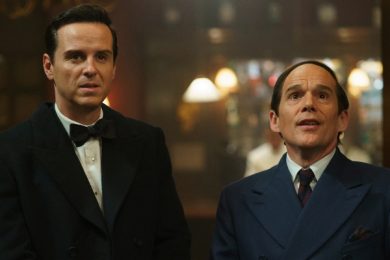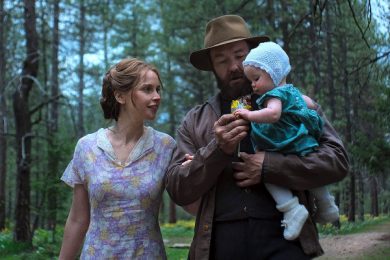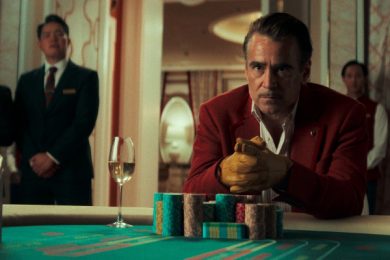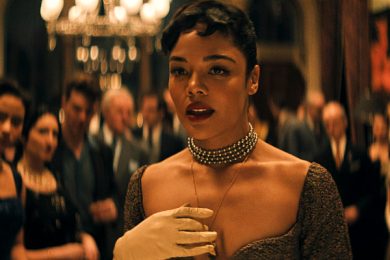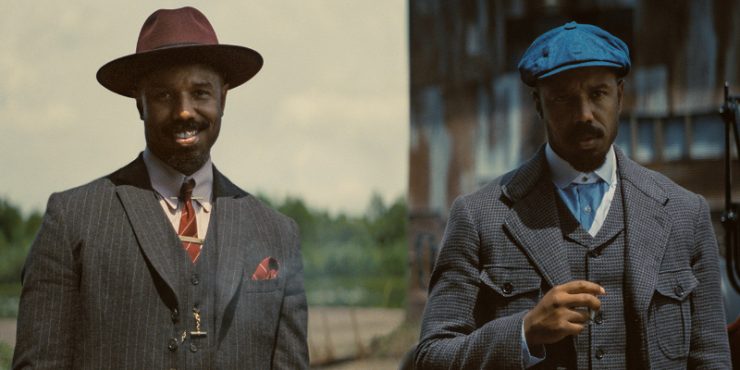After I watched Fruitvale Station in 2013, I knew that first-time director Ryan Coogler was a genuine talent, but I’ll confess that I couldn’t predict at that time the degree to which he was the heir apparent to Spielberg, Cameron, Hitchcock – ie, filmmakers whose remarkable cinematic and narrative skill is equaled by their ability to tell commercial, mainstream stories. True art that is truly for the masses, a real populist streak runs through Coogler’s films. And yet, all of his movies still have something substantial to say, and he has the audacity to say it while still producing films at the largest scale. Creed was his spin on the Rocky franchise, while the Black Panther films were his entry into the MCU. Sinners is his first chance since Fruitvale twelve years ago that he’s telling his own story. And it’s well worth the wait.
In Sinners, Coogler dips into horror, but he’s got much more on his mind than genre tropes. Horror has become more fashionable among higher brow cineastes, thanks in no part to filmmakers like Jordan Peele, Ari Aster, and Robert Eggers, among others. Coogler’s exercise here pays homage to horror more in spirit than practice, though there is plenty of terrifying imagery. It involves vampires in the Jim Crow South. When you think you got the handle on the metaphor – the evil whites are bloodsucking vampires, and the unsuspecting Black population are their helpless victims – Coogler complicates it in ways you’ll never anticipate. Coogler isn’t speculating like Aster, nor worshiping aesthetic like Eggers. He’s drafting an epic tale about American life, through the lens of American music, in the vein of American horror – fictional and otherwise.
Coogler’s go-to leading man is Michael B. Jordan, the handsome, charismatic actor whose own skill is never better used outside of Coogler’s influence. Even his villain in the first Black Panther steals the movie. Coogler understands how to mine the vulnerability underneath Jordan’s beefcake physique, and he understands that Jordan’s vibrant exteriority is a perfect replacement for subtle interiority. Jordan plays two roles in Sinners, specifically both of the Smokestack Twins. The brothers hail from the Mississippi Delta, but after fighting the Germans in World War I, they built their reps stateside within Al Capone’s crew in Chicago. This all happens before the events of Sinners, which begins upon their fateful return to their hometown in the Fall of 1932.
Carrying a case no doubt filled with dirty cash, they purchase a saw mill from a racist landowner (David Maldonado) and plan to open a juke joint where all the local townspeople can put their feet up, listen to good music, and drink a sophisticated range of liquors. Smoke is the more serious of the twins, taciturn and profit-minded. Stack, frequently dressed with a fedora and a toothpick, is an easier pill to swallow, the fun one. Together, they make shrewd business, and their double-sided minds make it impossible for their foes to get anything past them. Their plan to build a juke joint is hasty but done with purpose. Having tasted city life, they’ve learned that racism exists the same up there just in another color. They’d rather be where they’re most comfortable – with “The devil we know”. That devil is also known as Jim Crow.
It might surprise many to learn that Sinners is a film about music. In fact, a short prologue in the film’s opening conjures mythological origins to music in Black American life. Coogler funnels this running motif through Sammie (newcomer Miles Caton), the twins’ younger cousin, the son of the local preacher and a preternatural talent on the guitar. Sammie looks up to his cousins, despite their misdeeds, and in turn, they offer to let him perform during the opening night of their juke joint. They draft Slim (an absolutely fantastic Delroy Lindo), to accompany on piano and harmonica. They reach out to Bo (Yao) and his wife Grace (Li Jun Li) to order the food, and they reconnect with their old friend Cornbread (Omar Benson Miller) to provide security.
Security they’re going to need after the arrival of Remmick (an insanely good Jack O’Connell), who on the surface appears to be a polite, white folk singer, but in reality is a vampire looking to wreck havoc on the twins’ opening night. Remmick begins building his bloodsucking posse after attacking a local couple (who also happen to be proud KKK members), and from then on he and his newly minted companions head over to the juke joint, where they hope to be invited inside. Annie (Wunmi Mosaku), Smoke’s former lover, certified mystic, and the joint’s resident cook, is the only person inside who appears to know the rules on how to survive. Meanwhile, Mary (Hailee Steinfeld), Stack’s flame from a previous time, thinks she can talk sense into Remmick and co. as the only white girl in the house.
This is the backdrop for Sinners, a movie that acknowledges early on the evil of the world, but ends up surprising you with just how it comes to light. Coogler has sole credit on the screenplay, and such should get sole credit for the film’s richness in theme, drama, and soul. It’s not just that he runs the violence of Jim Crow through genre (though he does do that quite well), but the specificity with which he makes his case heightens Sinners‘s effectiveness. There’s a sequence about an hour into the film where Sammie plays a song inside the juke joint. This is before things go South with Remmick and his clan. What could have been a simple music performance, a standout set piece for the young Caton (whose voice is extraordinary), instead turns into a one-shot of such extraordinary power and audacity. This is the moment when you realize that Coogler is not simply going for a good vs. evil binary.
And that doesn’t begin to scratch the surface of Sinners‘s incredible cinematic achievements. Filmed in IMAX, Coogler and cinematographer Autumn Durald Arkapaw, craft astonishing vistas, and stunning nighttime sequences. The moments when Sinners takes full advantage of its larger format really takes your breath away. I’ve already mentioned the film’s music, which not only includes the blues of Sammie and Slim, but the smooth Irish folk of Remmick. There’s also an incredible score, by Ludwig Goransson, which melds it all together into something truly phenomenal. Goransson has already proven himself to be an eclectic talent who can perform over a wide array of genres (starting with TV sitcoms like New Girl all the way to his Oscar-winning work on Oppenheimer), but eagerly watching the closing credits to see who composed the beautiful music and seeing his name appear was one of the biggest “I was unfamiliar with your game” moments of my entire life.
One can spend many a word on the greatness of Sinners, and still neglect to give proper credit to its remarkable supporting performances, which are ample. Lindo’s Slim is a stock character, a play on Walter Brennan’s drunk comedic relief, that evolves into something remarkably poignant and true. Steinfeld and Mosaku play two women heartbroken by the twins, and their two distinct responses to that heartbreak lay the foundation for the movie’s variety of experience. Jack O’Connell is the chief villain, a vampire that slowly begins to win the ensemble over to his evil quest. It’s terrifying work, but also a performance that utilizes O’Connell as a singer and dancer, skills he hasn’t gotten a chance to showcase before. His Remmick, in its charming menace, is an important factor to everything Coogler is attempting to accomplish; it’s not simply that he’s bad, but that he’s seductive, that makes the screenplay click into place.
Remmick represents not just white America’s violence against its Black citizens, but the absorption of their culture and their spirit. The attempt anyway. Perhaps the actual brilliance of what Coogler does here is in its ending, which snatches triumph from the jaws of tragedy. This is the movie’s most powerful metaphor: the inability of America – despite its best, most forceful efforts – to extinguish the spirit of Black Americans; a spirit that lives not only through its people, but through its storytelling, its art, and its music. Coogler takes a lot of big swings in Sinners, and you’d probably never refer to it as a “perfect” film, but there’s a sublimity in its messiness, in its willingness to lay itself bare for its audience. There’s bravery in making a film for a broad audience then confronting them with uncomfortable realities. Coogler’s ability to do this while still making a film as blissfully entertaining as Sinners is further proof that he’s amongst the best working in Hollywood today.
Written, Produced and Directed by Ryan Coogler




